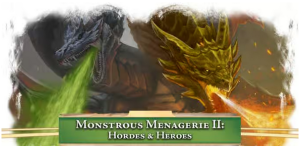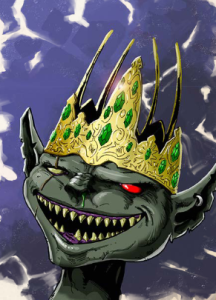 Hey, I’m the lead writer on EN Publishing’s new book, Monstrous Menagerie II: Hordes and Heroes! It’s on Kickstarter RIGHT NOW (assuming now is Dec 12 2024 or earlier!)
Hey, I’m the lead writer on EN Publishing’s new book, Monstrous Menagerie II: Hordes and Heroes! It’s on Kickstarter RIGHT NOW (assuming now is Dec 12 2024 or earlier!)
While Monstrous Menagerie 2 is mostly composed of brand-new monsters, we did take the opportunity to expand on some classic creatures that we think merit some more consideration. One of the monsters we revisited is the humble goblin.
Over the past few years, goblins have taken a real face turn–so much so that a few years ago, Oxford Dictionary named “goblin mode” its word of the year. To Oxford Dictionary, it means “a behaviour that is unapologetically self-indulgent, lazy, slovenly, or greedy, typically in a way that rejects social norms or expectations,” which seems to me like a pretty negative way to describe staying home to wear sweatpants and eat ice cream.
Here’s the thing: the idea of goblins as adorably antisocial little guys is, I think, fairly new. If we look at the history of goblins in fantasy literature, there are some interesting, unexplored through lines.
 Let’s start with the wellspring of so much of the fantasy genre: Tolkien. Goblins are a major adversary in The Hobbit. Far from being feral little fellows, we find that goblins are high-tech, with what appears to be a well-ordered society. Their leader, the Great Goblin, as he questions the dwarves about their intrusion into his realm, is rather urbane–until a goblin produces Thorin’s sword, Orcrist the Goblin Cleaver, which understandably throws the Great Goblin into a rage.
Let’s start with the wellspring of so much of the fantasy genre: Tolkien. Goblins are a major adversary in The Hobbit. Far from being feral little fellows, we find that goblins are high-tech, with what appears to be a well-ordered society. Their leader, the Great Goblin, as he questions the dwarves about their intrusion into his realm, is rather urbane–until a goblin produces Thorin’s sword, Orcrist the Goblin Cleaver, which understandably throws the Great Goblin into a rage.
According to my cursory research, it seems like Orcrist was mostly cleaving goblins around the year 510 in the First Age, while The Hobbit takes place in 2942 in the Third Age. I’m not an expert in Middle Earth chronology but that seems like… a long time. With historical memory like that, these aren’t “Garg Eat Rocks” goblins. Tolkien has lots of bad words to say about goblins—”ugly”, “cruel”, “wicked”, and “lazy”, and with gross flat feet—but he doesn’t deny that they’re historians. (And possessed of a series of national alliances to boot: when Gandalf kills the Great Goblin, in revenge another goblin monarch raises an army of many thousands of goblins.)
Prior to Tolkien the history of goblins is a bit muddied: in English-language literature the words for all the fey creatures are often used interchangeably. “Goblin”, “dwarf”, “kobold”, “gnome”, and “fairy” are often the same thing. But there are some books that specifically mark out goblins as a specific species. The Worm Ouroboros, by E. R. Eddison, is a 1922 fantasy classic, admired by Tolkien, in which Goblinland is a mighty nation. The lords and kings of Goblinland, like everyone in The Worm Ouroboros, are characters of towering Shakespearian dignity. And I’m not kidding about Shakespearean: here’s some of the goblin Lord Gro’s dialogue:
“How shall not common opinion account me mad, so rash and presumptuous dangerously to put my life in hazard? Nay, against all sound judgement; and this folly I enact in that very season when by patience and courage and my politic wisdom I had won that in despite of fortune’s teeth which obstinately hitherto she had denied me: when after the brunts of divers tragical fortunes I had marvellously gained the favour and grace of the King, who very honourably placed me in his court, and tendereth me, I well think, so dearly as he doth the balls of his two eyes.”
(Imagine running a game of D&D and saying that in character as a goblin!)
Now let’s go further back, to George MacDonald’s 19th century The Princess and the Goblin (also admired by Tolkien, and therefore also part of the DNA of modern fantasy literature and fantasy gaming). Unlike The Worm Ouroboros and like The Hobbit, MacDonald presents his goblins as grotesque, bestial, cruel creatures with gross feet. (Typical human propaganda!) However, once again these goblins are technologically adept miners, and they have all the trappings of a strong and sophisticated monarchy. Here’s the Goblin King and his court addressing his people:
At the other end of the hall, high above the heads of the multitude, was a terrace-like ledge of considerable height, caused by the receding of the upper part of the cavern-wall. Upon this sat the king and his court: the king on a throne hollowed out of a huge block of green copper ore, and his court upon lower seats around it. The king had been making them a speech, and the applause which followed it was what Curdie had heard. One of the court was now addressing the multitude. What he heard him say was to the following effect: ‘Hence it appears that two plans have been for some time together working in the strong head of His Majesty for the deliverance of his people. Regardless of the fact that we were the first possessors of the regions they now inhabit; regardless equally of the fact that we abandoned that region from the loftiest motives; regardless also of the self-evident fact that we excel them so far in mental ability as they excel us in stature, they look upon us as a degraded race and make a mockery of all our finer feelings. But, the time has almost arrived when–thanks to His Majesty’s inventive genius–i0t will be in our power to take a thorough revenge upon them once for all, in respect of their unfriendly behaviour.’
When we put these three versions of goblins together, what do we get?
In other words, perhaps accidentally, these three English authors invented a fantasy monster that is extremely English.
When original D&D came around, it basically stuck to this script. It didn’t do much to describe goblins except that they hate dwarves and “when in their lair the ‘goblin king’ will be found. He will fight as a Hobgoblin in all respects.” In further editions, goblins descend further and further into ineffective, semi-comic barbarity.
I am here for the “Garg eat rocks” goblin, but I sure like the highfalutin, palace-politics goblin too. Why not have both?
A first thought might be to use hobgoblins for this type of highbrow goblin. And it’s not a bad thought at all. But hobgoblins have sort of developed their own thing. Whereas the goblins of literature are subterranean miner-monarchists who mostly want to be left alone with their ugly feet, hobgoblins are the expansive and outgoing Roman Empire who covet a surface empire.
Here’s my pitch: just as gnomes have deep gnomes and dwarves have deep dwarves, goblins have deep goblins. Surface goblins are the familiar gnaw-on-rocks, battling-to-survive bandits with no social institutions to speak of. They are the heirs to fallen goblin kingdoms, and their small clans are prey to every passing warmonger and adventuring party.
Meanwhile, far underground are the kingdoms of the deep goblins. These kingdoms never fell, and their technology and cultures are just as advanced as anyone else’s, or more so. As Tolkien says of goblins, “wheels and engines and explosions always delighted them.” If anyone in your fantasy campaign manufactures firearms and grenades, it’s likely to be the goblins. Furthermore, deep goblins nurse grudges against most other intelligent creatures. They’re perfectly aware of what happened to the surface goblin kingdoms, and how those goblins have been treated since by the humans and dwarves. (And I bet they don’t much care for grimlocks and dark elves either.) With well-equipped armies in the thousands, there’s no reason why the deep goblins couldn’t conquer a lot of the world, except they don’t particularly care for the sunlit parts of it–but don’t press them too far, because they might change their minds if you get them mad enough (as they’ll happily explain to you, in high Elizabethan diction.)
This is the route we’re going with goblins in Monstrous Menagerie II. Where Monstrous Menagerie presented the typical hard-luck surface goblins and the “I’ve watched 300 a dozen times” hobgoblins, Monstrous Menagerie II brings us deep goblins. They’re tough opponents, suitable foils for mid-level, deep-delving adventurers. Their rulers are politically astute and trained in war, ever prepared to defend their realms. Like all A5E goblins, they’re at least a little fey-touched and armed with strange magic. And one dark night, the deep goblins might just venture “Upstairs” to give the world a taste of their power, and then we’ll all be in trouble.
That’s my pitch on deep goblins! If that sounds cool, or you want to take a look at the other 300 odd monsters in the book, you can get it all in Monstrous Menagerie II: Hordes and Heroes. The PDFs fulfill the very moment the Kickstarter ends, and the books and PDFs are on sale afterwards, so you can get your hands on the book real soon.








Don’t forget World of Warcraft goblins! Both those goblins and orcs have been responsible for a seismic shift in their understanding.
I did forget about them! Yeah, those guys bring back the old-school high-technology goblin while marrying it to the comic hijinks goblin, right?